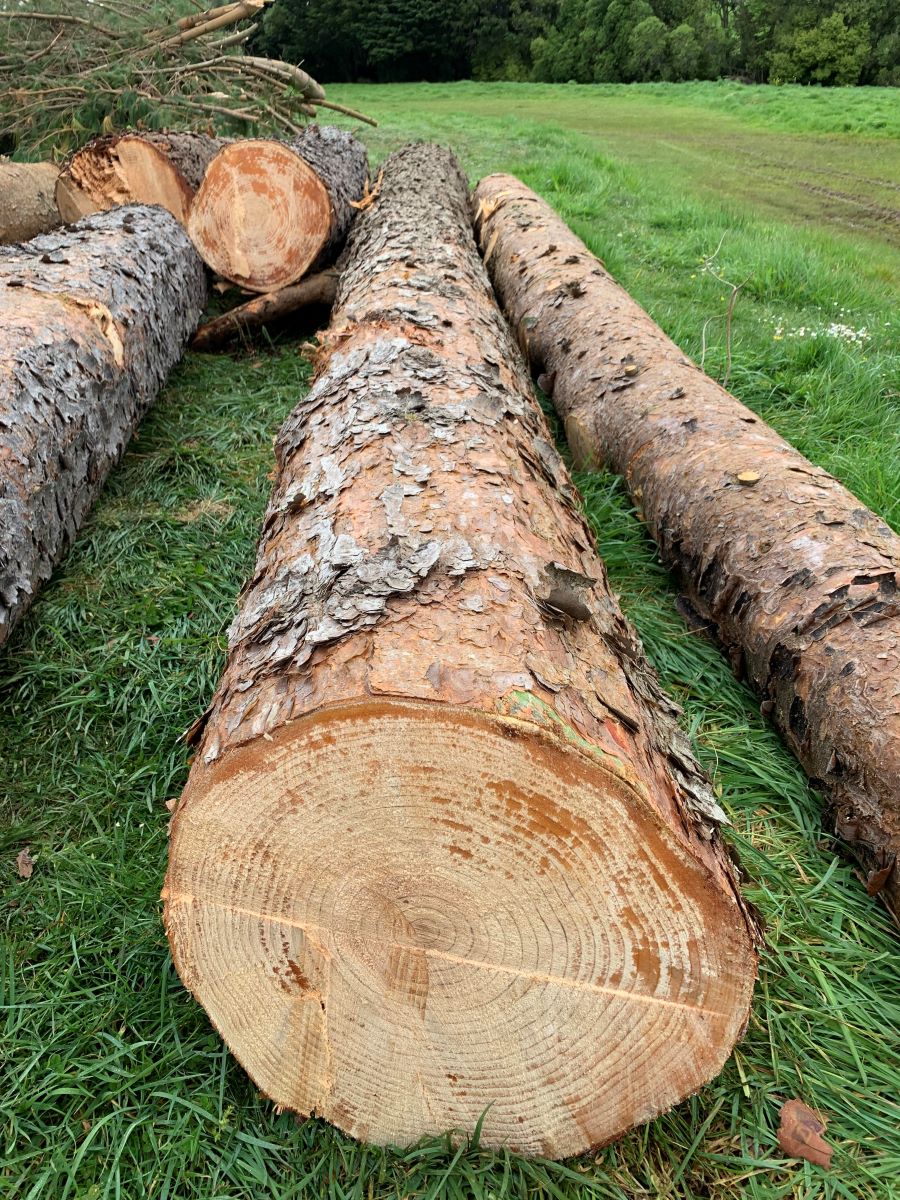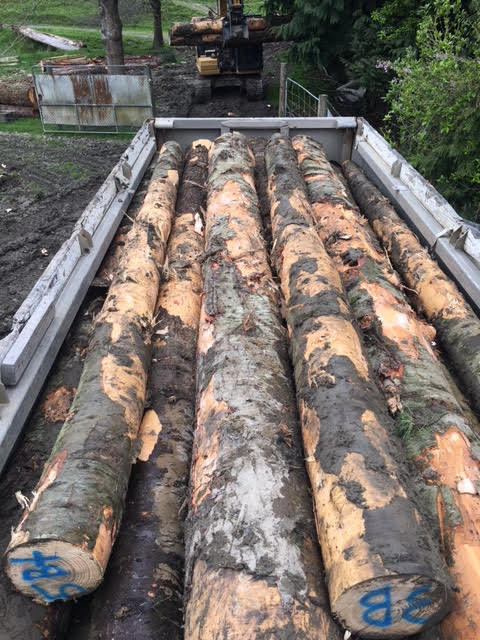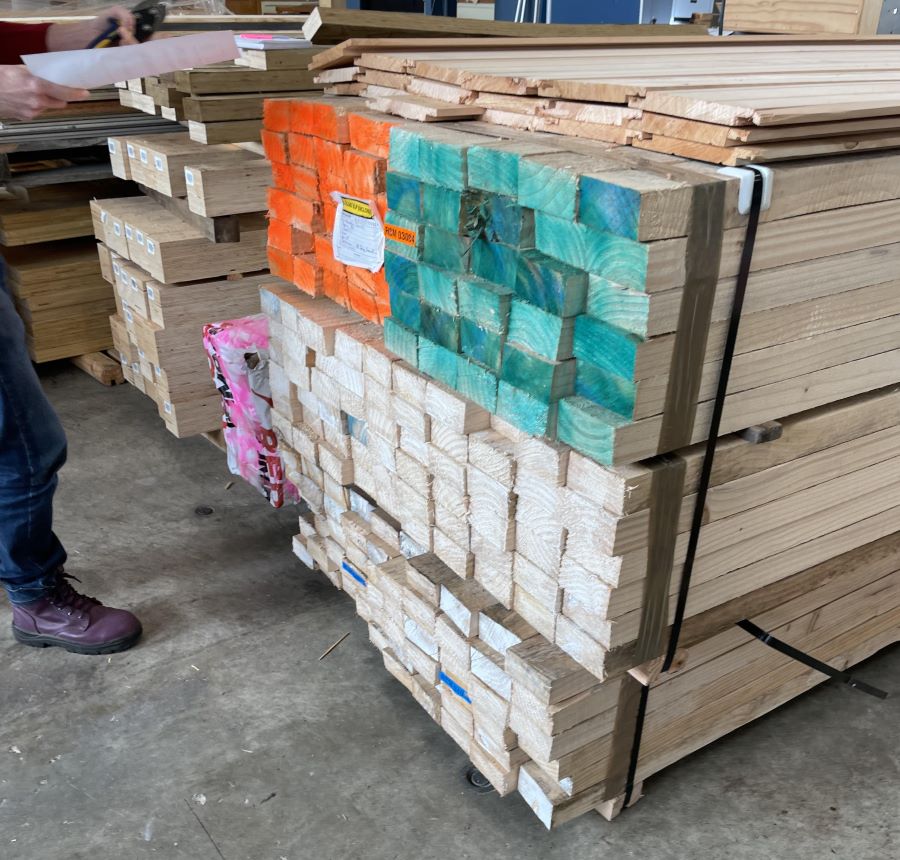Abies grandis bending strength and stiffness
By Dean Satchell and Vaughan Kearns, August 2024.
Eleven Abies grandis trees were harvested early September 2022 from the upper Pohangina Valley, in the Manawatu District. The growth rings showed an age of 30 years. The trees were closely spaced on flat fertile farmland adjacent to a creek. The trees were production thinned (every second tree where possible) from a small block that was about 6 rows deep. From the 11 trees 33 logs were cross cut, 3 from each stem.


The trees were transported to Ruapehu sawmills and sawn between the 5th and 15th of October, then placed straight into fillet and air dried.
The nominal sawn recovery was:
| Log position | Green sawn recovery (m3) |
|---|---|
| Butt logs | 6.06 |
| Mid logs | 4.49 |
| Top logs | 2.66 |
| Total | 13.21 |
Visual grading was performed on all of the sawn timber. All boards achieved No. 1 framing grade, except those with damage from logging and extraction.
Six packets of 100mm x 50mm No. 1 framing grade were shipped to Scion for destructive strength/stiffness testing in April 2023.

180 x 2m samples were selected according to position in tree, noting that boards with wane and pith were excluded. Outer boards were sawn to 25mm so outer wood was also not included in test samples. Destructive testing was undertaken at Scion for strength and stiffness and density during September 2023. Six packets of timber were tested:
| Description | Pieces |
|---|---|
| Butt log, outer boards | 30 |
| Buttlog, near core (no pith) | 30 |
| Mid lig | 30 |
| Headlog | 30 |
| Buttlog, quartersawn | 30 |
| Buttlog, flatsawn | 30 |
| Total | 180 |
Test methods are described in Scion's report.
Results
| Description of packets | Average Nominal Density kg/m3 |
Average MoE GPa |
Average MoR MPa |
|---|---|---|---|
| Butt log, outer boards | 341.56 | 8.39 | 37.83 |
| Buttlog, near core (no pith) | 359.62 | 6.78 | 30.43 |
| Mid lig | 351.74 | 8.09 | 34.36 |
| Headlog | 333.99 | 6.70 | 26.65 |
| Buttlog, quartersawn | 342.66 | 7.37 | 31.61 |
| Buttlog, flatsawn | 366.20 | 8.4 | 33.93 |
| All packets combined | 349.29 | 7.62 | 32.47 |
| SG Grade | All boards | Outer boards* |
|---|---|---|
| Fail | 10.5% | 1.6% |
| SG 6 | 52% | 38.3% |
| SG 8 | 29% | 41.7% |
| SG 10 | 8% | 16.7% |
| SG 12 | 0.5% | 1.7% |
Characteristic strength and stiffness for all packets combined achieved SG 6 grade. Characteristic strength (16.27 MPa) achieved SG8 and characteristic stiffness (7.420 GPa) achieved slightly less than the 8 GPa required for SG8.
Characteristic density at test was 386 kg/m3 and characteristic nominal density was 346 kg/m3.
Full results are available in Scion's report.
Discussion and conclusions
NZS AS 1720.1 Timber structures Part 1: Design methods (once cited into the NZ building code) will become a verification method under clause B1VM1 of the building code (currently 1st addition amendment 21, November 2023). However, although NZS AS 1720.1:2022 will supersede NZS 3603:1993, NZS 3603:1993 remains referenced within the Building Code and is the cited verification method for now. Both standards are verification methods that require the structure to be designed and signed off by an engineer.
AS/NZS 1720.1 provides two options for structural timber in New Zealand, verified and unverified timber. Verified SG6 grade timber is defined in AS/NZS 1720.1 as having a minimum characteristic density of 330 kg/m3 (at 15% moisture content) and a characteristic stiffness of 6 GPa. However, AS/NZS 1720.1 requires that non-verified timber has an average density of at least 400 kg/m3 (at 15% moisture content). Because the average density at test for Abies grandis from this study was 390.22 kg/m3 (at 11.7% moisture content), this arbitrary requirement would limit Abies grandis to verified timber grades.
Abies grandis timber from this study was lower in density that radiata pine (Table 3), but stiffness, although slightly lower on average than radiata pine, was high for the density. Comparative data for high density and low density radiata pine (Walford, 1982) is presented in Table 3:
| Description | Average Nominal Density | Average Moisture Content at test | Average MoE GPa |
Average MoR MPa |
|---|---|---|---|---|
| Low density | 405 | 11% | 6.38 | 22.61 |
| High density | 457 | 13% | 9.0 | 35.82 |
In practice, the results from this study would effectively limit Abies grandis timber production options to machine grading for mostly SG8 and SG6 verified structural timber under AS/NZS 1720.1. However, until AS/NZS 1720.1 replaces NZS 3603, the Scion report provides verification of characteristic stiffness, strength and density and values an engineer could use for structural design using Abies grandis under NZS 3603 Timber Structures standard.
For verification, characteristic values are required and this study provides three of those: Strength, stiffness and density. These are the values required for designing most structural elements such as joists, rafters, and studs. Where specific characteristic values are required, only those values need to be evaluated. AS/NZS 1720.1 lists other characteristic values that could be evaluated for Abies grandis, including Compression parallel-to-grain (some compression strength is required for studs*) and Tension parallel-to-grain (required for bottom chords of trusses).
Of interest was the variation in stiffness and strength according to log position. Although only a pilot study using 30 year-old trees from one stand, the data suggests that strength, density and stiffness increase with cambial age. Height in tree does not appear to be a determinant of strength, but radial position does, with increasing values in older, outer wood.
References
* this has not emerged as a problem to date with any species (Doug Gaunt, pers. comm).
Walford, G. B. (1982) Comparison of the tensile and bending strengths of 100 x 50mm radiata pine, FRI Bulletin No. 21, Forest Research Institute, New Zealand Forest Service

 Farm Forestry New Zealand
Farm Forestry New Zealand
One post
Post from Vaughan Kearns on May 6, 2024 at 9:15PM
We used some of the spare 200x50 Abies Grandis for the top chord in the two trusses in the construction of our timber demonstration barn, build in 2023
They are no longer visible after lining the ceiling. They were substantially lighter than the adjacent Douglas fir that formed the balance of the rafters.
Here is a photo showing the D.fir rafters in place beside the two trusses.
Here are the trusses from underneath, now that the ceiling is lined.
Add a post